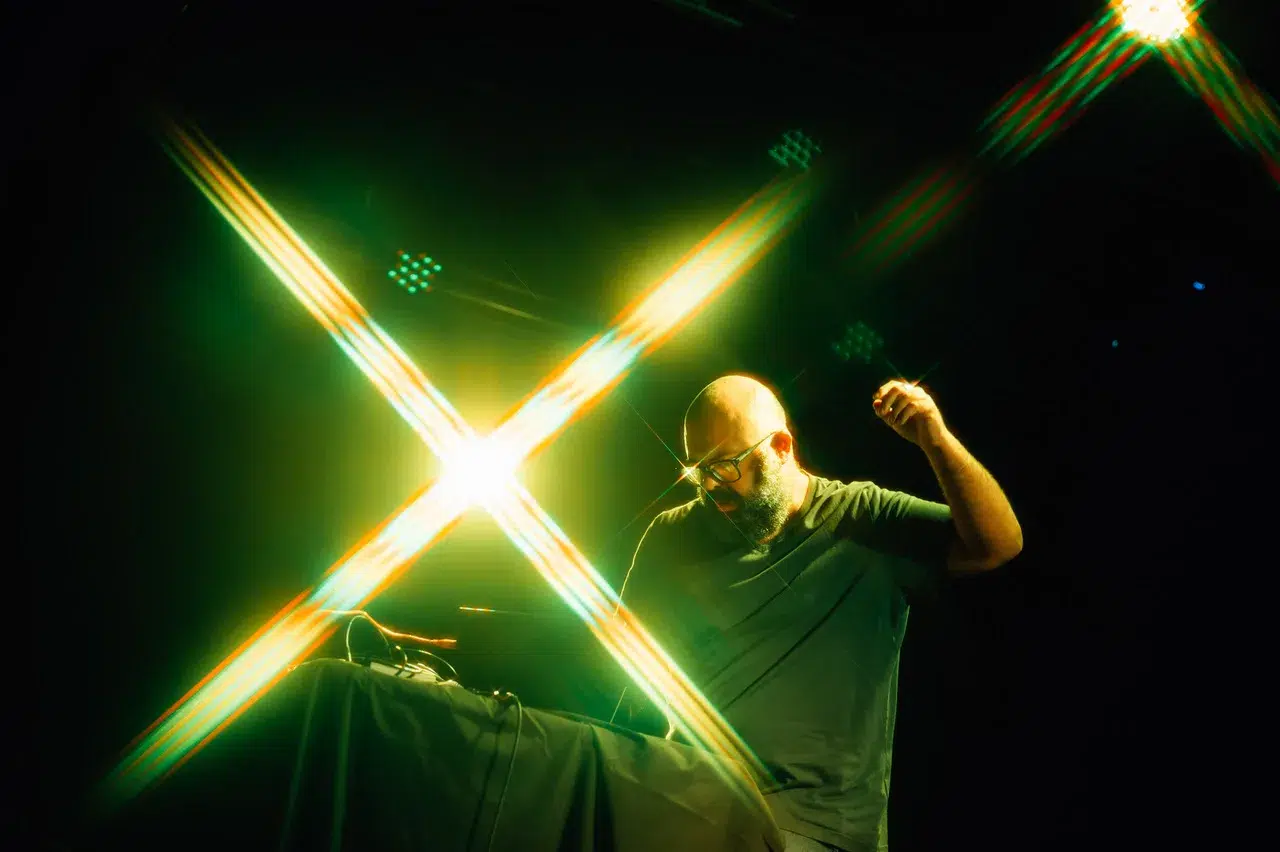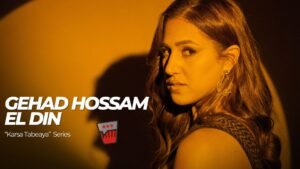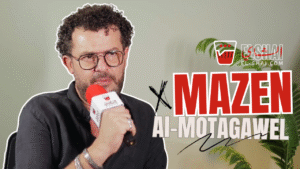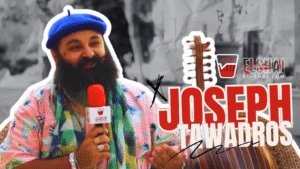In the vibrant landscape of experimental music and multimedia art, few artists captivate audiences as profoundly as Hassan Khan. Renowned for his innovative fusion of hip-hop and generative music, Hassan Khan’s upcoming performance at D-CAF Egypt promises an immersive experience like no other.
In this exclusive interview, we delve into the creative process behind his unique blend of hip-hop and multimedia art, exploring the themes that underpin his work and the influence of global cultures on his creative expression. Join us as we unravel the mind of this extraordinary artist, whose groundbreaking performance, “The Infinite Hip-Hop Song Live!“, is set to enthrall audiences at Rawabet Art Space, Cairo, on Saturday, 21st October 2023.

Can you tell us more about your upcoming performance at D-CAF Egypt?
The Infinite Hip-Hop Song Live! is a concert set that I developed from my generative music installation with the same name. Basically, I hook up a customized tablet to a mixer with some effects and I use it to control a massive library of bass lines, beats, melodies, and rapped bars to produce one long modulating blast of out-there music and lyrics that I identify as hip-hop.
What inspired this unique blend of hip-hop and multimedia art?
Well, it’s not really a blend of art and music – it’s just someone using their tools to craft something new and share it with an audience. The impetus behind this project was trying to touch the emotional conditions we collectively share- the unembarrassed desires and ambitions, the fears and paranoias, the hesitations, a sense of amazement and apprehension, a fascination and a confidence in our ability as human beings to produce sublime moments as well as nightmares.
Your work involves a fusion of recorded studio vocals and programmed musical elements. How do you navigate the creative process to seamlessly blend these elements during your live performances?
I recorded ten songs with eleven rappers in a studio over the span of ten long crazy days. These sessions were then chopped up and organized into a database of vocal units of varying lengths- from one line to a complete song. They are part of a bigger database that includes all the bass lines, beats, and melodies that I produced earlier for the generative music installation. I can access this database through my interface.
When I am performing the piece I am basically diving through this material and assembling the tracks from all these elements.
In this, I rely on both my instinct and a sense of structure. One of the figures that has influenced me the most has been the great Munshid Yasin Al Tuhami who once (in the 90s) when asked how he begins singing described how he knows by heart thousands of lines of poetry from the whole tradition and that when he begins his Inshad he can visualize this vast library and when he falls in love with one line he begins by singing that line. It might seem strange but there is some similarity to this approach.

Could you elaborate on the themes explored in your music and how they reflect our collective human experience, as mentioned in your description?
Yes! So I started getting into hip-hop in 2016 when I noticed that Egyptian hip-hop had mutated from the lameness of Omy Mesafra into something that made much more sense with the world we live in.
It actually made sense within the wider context of the world – desires, ambitions and the unembarrassed were colliding with what people wanted and how they expressed themselves, remember at the time the craziness of Trump (and other dangerous populist around the world) being in ascendance which I believe actually hinted at some latent perverse need by societies to reorganize their symbols.
What I mean is that the hypocrisy of modern progress was in some secret way being punctured and I think my lyrics come from that moment as well. Fear is one motivator but also the collapse of values, hypocrisies, old orders, and the inability to really formulate the new.
The lyrics are haunted by trying to come to terms with all of that and to try to express this through a collective position rather than through the male ego – which is partially why the music is based on hybridizing styles and approaches rather than imitating any one thing.
Basically, I soaked up lots of stuff and I tried to learn from what attracted my attention and to then speak it in my own voice –it then became something else. These words from Tricky’s “Christian Sands” (from his 1996 album Pre-Millennium Tension) come to mind: “It means we’ll manage / I’ll master your language / And in the meantime I’ll create my own,” which I guess has been part of how I’ve been working from the beginning whether consciously or not.
Your performances have taken you all over the world, from Paris to Taipei. How does the cultural diversity of these places influence your creative expression, especially in the context of hip-hop and experimental music?
I’ve been constantly travelling around the world for the past 25 years – in some ways, you always meet people in different places whom you connect to. There is also of course a global culture of shared references and even experiences.
Though yes of course on the other hand cultural specificity, and histories mean that places are very very different. However, humans all over the globe do share certain conditions. It is a paradox and I have no neat answers for it.
Congratulations on your recognition at the 57th Venice Biennale. Can you share more about the piece that earned you the Silver Lion and how it connects with your broader body of work?
Thanks! I am going to try to be short here because Composition for a Public Park (2013) is quite a large-scale and very ambitious work. Put simply it’s a multi-channel musical composition laid out spatially in a public park.
When you walk through the park you walk through the music – it is composed of three movements (each one has a different instrumentation and musical language) which are synchronous – i.e. they are all playing at the same time but in different places.
Basically, the composition physically becomes the park. Each of these movements has a libretto that is recited by a male and female voice in the language of the country it is installed in (I so far have English, Italian, French, Urdu, and Arabic versions of the piece).
The three texts (each for a different movement) revolve around themes that I am concerned with (and that actually also appear in The Infinite Hip-Hop Song) – Stasis and Majestyrevolves around the emotions of aspiration and ambition as well as exhaustion and melancholy; The Revolving Jewel is a fluid act of seduction which is also about control and loss; while No Political Romanticism tries to inhabit the voice of power as it taunts the temporarily defeated and in a way strips bare the brutal conditions of co-existence.
Together they form a portrait of our contemporary urban shared life – and when you are in a park, bracketed and suspended, somehow seeming to step out of history (even if that is an illusion) one can let go and in a way reflect on their own emotional condition in this world. I hope the piece gives people a very intimate as well as very public experience at the same time.
Your exhibition “The Keys to the Kingdom” in Madrid received significant attention. What was the inspiration behind this exhibition, and how did you approach the integration of choreography, music, and visual elements to create a narrative?
The Keys to the Kingdom is the exhibition in which The Infinite Hip-Hop Song (the installation version) premiered in. It took as its starting point a highly disturbing, racist nineteenth-century table I saw at the Museum of Romanticism in Madrid. The gilded marble tabletop was supposed by the figure of an upside-down dehumanized slave, and this relation between seeming beauty and elegance and brutal exploitation seemed to be very honest about how these Empires were built.
I started with this and attempted to produce an exhibition that dealt with being in public, with spectacle, that played around with the codes and keys of symbols and power, and that harvested the energy of public spaces to produce a political and aesthetic moment.
Sorry, I hate to be so abstract especially if someone hasn’t experienced the work but in a nutshell, it’s an exhibition born out of the grotesque and the sublime and their shadow in contemporary populist politics with a touch of the clumsy and the uncanny.
Incorporating an AI interface into your music production is innovative. How do you see technology shaping the future of music and art, particularly in experimental and multimedia contexts?
Just to be precise the concert version of this piece does not involve AI- only the installation version does. However, the whole project is influenced by the fact that I originally produced the content for a generative music set-up. This has affected the process as well as the actual music.
The live version uses technology (the interface) to take back the music from the power of the algorithm and allow the human musician the chance to craft this into a performance shared with an audience. So there are paradoxes here but I think they make sense.
Maybe in this way, one finds a path to produce something without being a shadow of something else- to make something new without trying to make something new. Finally, technology of course has a huge impact – but our hands themselves are actually the very first technology.
This is not a new discussion, since we as a humanity have begun using tools this relationship has existed and will continue to exist. We both shape technology and technology shapes what we do – which is really at the heart of my project.
You’ve been involved in the global music scene for quite some time. How have you seen the landscape of experimental music and hip-hop change over the years, especially in Egypt with the recent rise in the genre, and where do you think it’s headed in the future?
Music like other forms is always evolving – in Egypt what has changed, especially post-revolution, is the final end (phew thank god!) of the dominance of pop over the mainstream market. Which Is a huge thing of course.
What usually happens is that there is an underground of highly innovative raw and untamed stuff that is produced at a certain time and that is for lack of a better word real – I find this to be usually a super interesting time – in the mid-2000s it was like that with New Wave Shaabi before the complete domination of the standardized mahraganat format – so much amazing and weird music was produced then which of course lead to that mahraganat wave afterwards.
Now with hip-hop, it feels a bit similar maybe a few years ago there was a little more rawness, innovation, and diversity which has now been mostly commodified (there are some really good artists though!). But as always I am confident there will be new waves and transformations.
I have belief in the music scene in Egypt- which is highly interesting though unfortunately there is a lack of space for difference and the strident power of the market tends to drown a lot of amazing things.
Your work seems to blur the lines between different art forms, such as music, performance, and visual arts. How do you believe this interdisciplinary approach enhances the audience’s experience and understanding of your creations?
I don’t think of it as interdisciplinary. I think of it as just how I do things.
Finally, what message or emotion do you hope your audience takes away from your performances, particularly from your upcoming show at D-CAF Egypt?
Well, the short answer is that I hope those who come to the concert are blown away.
The long answer is that I hope they are engaged, thrilled, put in a daze, psyched, moved, become sensitized to ideas and emotions, all in all have a powerful and rich experience that can stay with them for a long time. Of course, they could also just be bored.
As we conclude our conversation with Hassan Khan, we are left inspired by his passion for pushing artistic boundaries and his dedication to crafting immersive experiences for his audience. The upcoming performance at D-CAF Egypt promises to be a night of unparalleled creativity, where music, emotion, and technology converge to create something truly extraordinary.
We invite you to witness this fusion of art and expression on Saturday, October 21st, 2023, at the Rawabet Art Space in Cairo. Tickets are available at this link.





